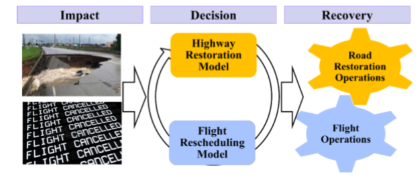Dr. Xiulu Qu: Integrated Decision Making Model for the Restoration of Air and Road Transportation Systems after a Hurricane
Transportation Research Spotlight

Dr. Xiuli (Shelly) Qu is an associate professor in the Department of Industrial and Systems Engineering at N.C. A & T. She received her MS and Ph.D. in Industrial Engineering from Purdue University. Dr. Qu has expertise in optimization modeling and data mining of complex systems and experience in the development of simulation and optimization models for planning and scheduling in transportation system restoration, emergency response systems and healthcare delivery systems. Her recent research focuses on developing decision making models and tools for road protection and restoration and emergency evacuation during a natural disaster while considering the detection and predictive models of cyber disruptions to transportation systems during emergency evacuations. Dr. Qu has authored/co-authored over 50 peer-reviewed journal or conference papers.
Over the past decade, the frequency and intensity of natural disasters has increased, causing significant losses and disruptions to infrastructure, businesses and communities across the nation. Critical transportation systems are also significantly disrupted by natural disasters, such as hurricanes, winter storms and floods. The interruptions in transportation systems directly impact humanitarian activities responding to a disaster which may then trigger cascading effects on other vital services and associated industries. Therefore, quick restoration and recovery of transportation systems play an important role in humanitarian operations and community recovery after natural disasters.
However, being able to anticipate, prepare for and respond to a disruption in transportation systems is a complex decision-making process incorporating many factors ranging from system use to system preparation. To address these challenges, Qu’s research team developed decision-making models for flight rescheduling and road restoration after a hurricane and integrated the models to create a visual decision-making tool.
The computational time of decision making for road restoration and flight schedules recovery was within five minutes in the case study. The results show that for flight rescheduling 65 percent of passengers and flights can be rescheduled within 24 hours, and all canceled flights can be rescheduled with 48 hours. For short-term road restoration, the road transportation network can be reconnected within 52 hours. Using the framework proposed in the study, an emergency manager could prioritize the restoration activities to minimize the negative impact of natural disasters on the transportation system.
The resulting integrated model and visual tool will serve to improve the effectiveness and efficiency of response activities in local and regional transportation systems during an emergency event, such as a hurricane. Deploying effective response activities to a hurricane can aid the mobility of people and disaster relief efforts during and after a hurricane, which ideally means better safety and more lives saved.
The framework was tested using the impact data of Hurricane Matthew on North Carolina. Hurricane Matthew was a category five hurricane occurring in late September through early October of 2016. Matthew caused catastrophic damage and a humanitarian crisis in Haiti, and widespread devastation in the southeastern U.S. Following the storm, more than 600 roads closed, some for as long as 21 days and more than 5000 flights were canceled in the U.S. with some airports closing between October 5 –9.

The computational time of decision making for road restoration and flight schedules recovery was within five minutes in the case study. The results show that for flight rescheduling 65 percent of passengers and flights can be rescheduled within 24 hours, and all canceled flights can be rescheduled with 48 hours. For short-term road restoration, the road transportation network can be reconnected within 52 hours. Using the framework proposed in the study, an emergency manager could prioritize the restoration activities to minimize the negative impact of natural disasters on the transportation system.
The resulting integrated model and visual tool will serve to improve the effectiveness and efficiency of response activities in local and regional transportation systems during an emergency event, such as a hurricane. Deploying effective response activities to a hurricane can aid the mobility of people and disaster relief efforts during and after a hurricane, which ideally means better safety and more lives saved.


